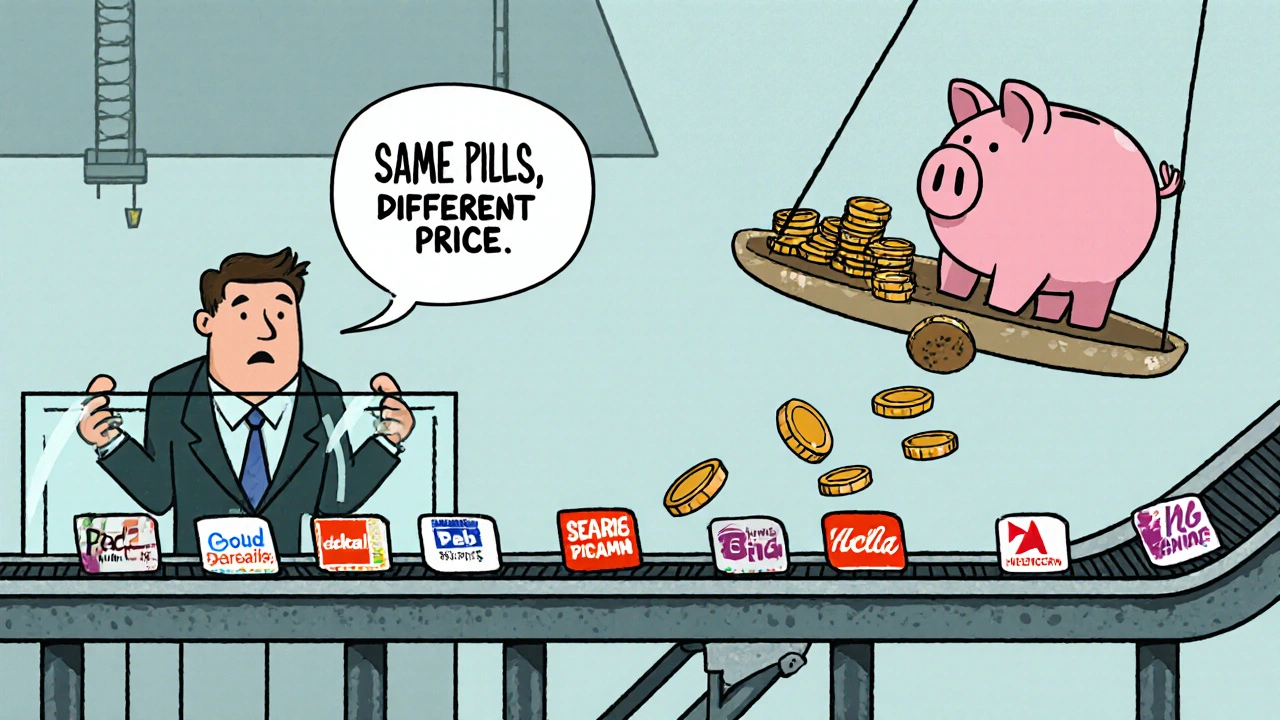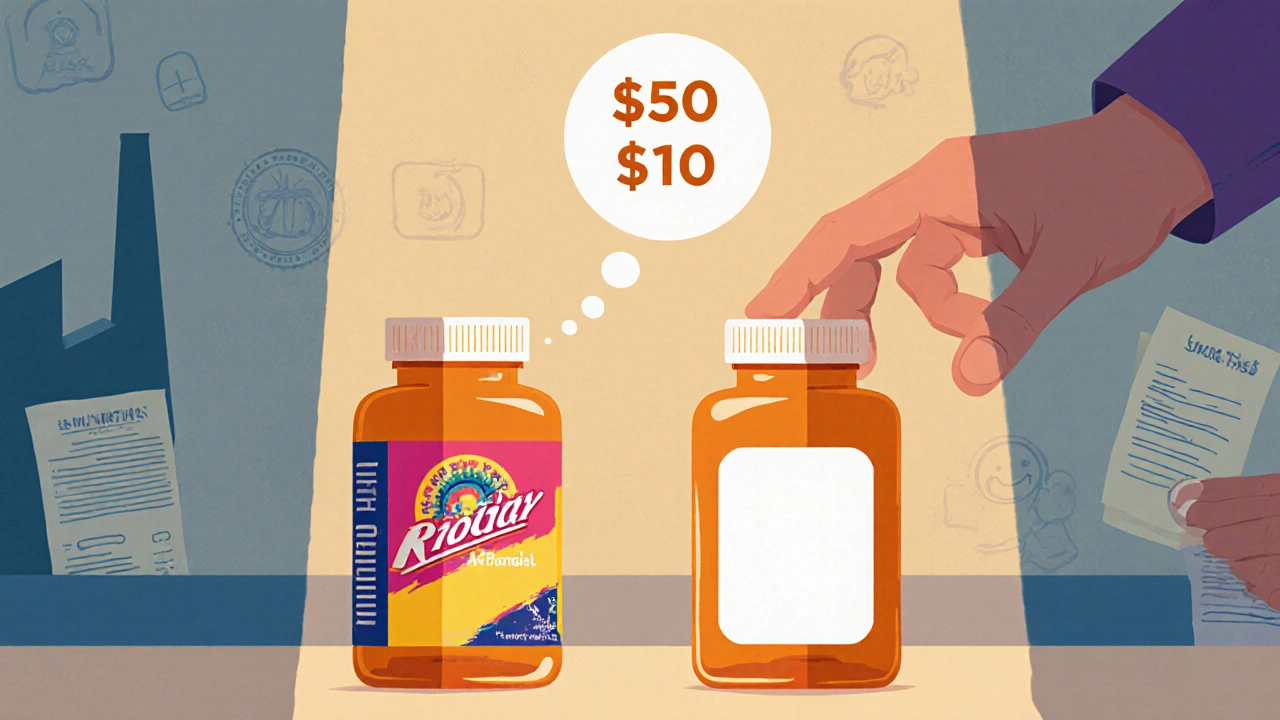Ever checked your prescription receipt and wondered why two pills that look and work exactly the same cost $10 versus $50? That’s not a mistake. It’s authorized generics at work.
Authorized generics aren’t knockoffs. They’re the exact same drug as the brand-name version-same active ingredient, same factory, same quality control. The only difference? No fancy packaging. No marketing team. And a price tag that’s often 4% to 8% lower than the brand.
So why do they cost less? It’s not because they’re cheaper to make. It’s because of how the system works-and who’s playing the game.
They’re the Same Drug, Just Without the Brand Name
When a drug company develops a new medicine, they file a New Drug Application (NDA) with the FDA. Once approved, they get patent protection and market exclusivity. That’s when the brand-name version hits the shelves at full price.
But here’s the twist: the same company can also make an authorized generic. They don’t need a new approval. They just slap a different label on the exact same pills made in the same facility. The FDA requires them to report this, and they publish a quarterly list of authorized generics. As of October 2023, there were 137 active ones in the U.S.
Think of it like buying a Toyota Camry. The dealership sells it as a Toyota. But the same factory also makes identical cars with a different badge-say, a Lexus ES. Same engine. Same seats. Same safety ratings. Just a different name and price.
The Hatch-Waxman Act Started the Game
The whole system started with the Hatch-Waxman Act of 1984. It was designed to speed up generic drug access. It gave the first company to challenge a patent 180 days of exclusive rights to sell a generic version.
That sounds fair. But here’s what happened: brand-name companies didn’t want to lose market share. So they started launching their own generics-authorized generics-right when the 180-day clock started.
Instead of letting one generic company charge high prices during its exclusivity, the brand company stepped in with a lower-priced version of its own drug. Suddenly, the first generic had competition from day one.
The Federal Trade Commission found that when an authorized generic enters the market at the same time as a traditional generic, retail prices drop 4% to 8%. Wholesale prices? They fall even more-7% to 14%.
Why Do Authorized Generics Cost Less?
It’s simple: no advertising. No sales reps. No brand loyalty campaigns. No expensive packaging. No patent protection fees.
Brand-name drugs spend billions on marketing. They pay doctors to prescribe them. They run TV ads. They create patient support programs. All of that gets baked into the price.
Authorized generics skip all of that. The manufacturer already has the drug made. They already have the distribution network. They just need to change the label and ship it out. The cost to produce one pill doesn’t change-but the cost to sell it does.
Take the EpiPen. In 2016, Mylan raised the price to $600. Public outrage followed. So they released an authorized generic for $300-half the price. Same device. Same epinephrine. Same life-saving function. Just no brand name.
It’s Not Always Cheaper for You-Here’s Why
Here’s the catch: just because an authorized generic is cheaper doesn’t mean you’ll always pay less at the pharmacy.
Pharmacy Benefit Managers (PBMs) control which drugs go on which tier of your insurance plan. Sometimes, they put the authorized generic on the same tier as the brand-name drug. That means you pay the same copay-$40 for both.
Other times, they put the authorized generic on a lower tier. That’s when you actually save. A 2022 study of 1.2 million Medicare Part D patients found that when AGs were placed on the same tier as traditional generics, adherence improved by 8.2 percentage points. People filled their prescriptions more often because they could afford them.
But if your plan favors the brand, you won’t see the savings-even if the pharmacy is selling the authorized generic for $10 less.

How Authorized Generics Change the Market
Before authorized generics, the first generic company had a free pass. No competition. They could set prices high and keep them there for months.
Now? It’s a race from day one.
Medicaid data shows that when an authorized generic enters alongside a traditional generic, on-invoice prices (what pharmacies pay wholesalers) drop by 13% to 18%. That’s huge. It forces everyone else to lower prices too.
Compare that to drugs with no authorized generic. If only one generic enters, prices might drop 50% over time-but only after months of high prices. With an authorized generic, the drop happens fast.
And it’s not just about price. It’s about access. In categories like heart medications and antidepressants-where patients rely on consistent supply-authorized generics help keep drugs affordable and available.
Are They Safe? Are They Real?
Yes. Absolutely.
Authorized generics are held to the same standards as brand-name drugs. The FDA requires them to meet identical quality, strength, and purity benchmarks. They’re made in the same plants, by the same workers, with the same equipment.
There’s no difference in how they work in your body. No hidden ingredients. No cut corners.
Some people worry they’re “inferior.” That’s a myth. The only thing different is the label.
What About the Controversy?
Not everyone sees authorized generics as a win.
Some experts, like Dr. Peter Bach from Memorial Sloan Kettering, argue that brand companies sometimes use them as a tactic in patent settlements. Instead of letting a true generic company compete, the brand pays them to delay entry-and then launches their own version. This keeps prices high longer.
The FTC has looked into this. While they found no evidence that authorized generics are more expensive than other generics over time, they’ve warned that the practice can be abused to delay competition.
Still, the data shows that in most cases, the presence of an authorized generic lowers prices across the board. Even if it’s a strategy, it’s one that benefits consumers.

Who Uses Them? And When?
Big pharma uses them strategically. About 67% of brand-name drugmakers have launched at least one authorized generic since 2010.
They’re common in high-revenue drugs: hepatitis C treatments like Harvoni and Epclusa, heart medications, antidepressants, and insulin.
They’re especially important now. With the Inflation Reduction Act capping out-of-pocket drug costs at $2,000 a year for Medicare beneficiaries, insurers and PBMs are under pressure to find affordable options. Authorized generics help them do that without switching patients to unfamiliar brands.
And they’re growing. Authorized generics make up about 12% of the $60 billion U.S. generic drug market. That’s billions in savings every year.
How to Get One
Ask your pharmacist.
When your doctor writes a prescription for a brand-name drug, ask if there’s an authorized generic available. If your insurance doesn’t automatically cover it, ask them to switch the prescription to the generic version.
Check your plan’s formulary. Look for the generic name of your drug. If you see “authorized generic” listed, it’s worth asking your pharmacy to fill it.
Some pharmacies will automatically substitute if the generic is cheaper. Others won’t. Don’t assume. Ask.
It’s not magic. It’s just smart shopping.
Bottom Line: You’re Not Getting a Second-Choice Drug
Authorized generics aren’t a compromise. They’re the real thing-just without the brand name. And that’s why they cost less.
If you’re paying full price for a drug that has an authorized generic version, you’re leaving money on the table. Not because you’re being careless. Because the system is confusing.
Next time you pick up a prescription, take two seconds to ask: Is there a cheaper version? Is it the same drug? If the answer is yes, you’ve just saved yourself hundreds-or even thousands-over the year.
It’s not about brands. It’s about getting the medicine you need at a price you can afford. And authorized generics make that possible.
Are authorized generics as safe as brand-name drugs?
Yes. Authorized generics are made in the same facility, with the same ingredients, and under the same quality controls as the brand-name version. The FDA requires them to meet identical standards for safety, strength, and effectiveness. The only difference is the label.
Why don’t pharmacies always offer authorized generics?
It depends on your insurance plan’s formulary. Pharmacy Benefit Managers (PBMs) decide which drugs get priority. Sometimes, they place the brand-name drug on the same tier as the authorized generic, so you pay the same copay. Other times, they put the generic lower, which saves you money. Always ask your pharmacist to check.
Do authorized generics work the same way in my body?
Yes. Since they contain the exact same active ingredient and are manufactured to the same specifications, they are bioequivalent to the brand-name drug. Your body processes them identically.
Can I switch from a brand to an authorized generic without side effects?
Yes. Millions of people switch between brand-name drugs and authorized generics every year with no issues. Because they’re identical in composition, switching doesn’t cause side effects or reduce effectiveness.
How do I know if my drug has an authorized generic?
Ask your pharmacist or check the FDA’s quarterly list of authorized generics. You can also search the generic name of your drug online-many drug databases list whether an authorized generic exists. If the brand manufacturer makes a generic version, it’s likely an authorized one.



Adam Hainsfurther
Authorized generics are one of those quiet wins in healthcare that nobody talks about. I’ve been switching to them for my blood pressure med for years. Same pill, same results, half the cost. My pharmacist even keeps a list of which ones are available. It’s not rocket science-just common sense.